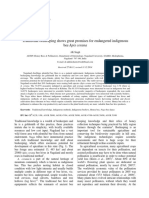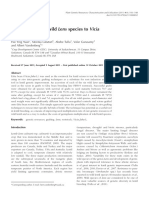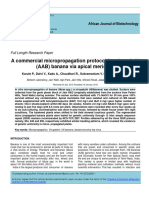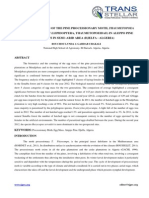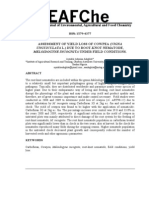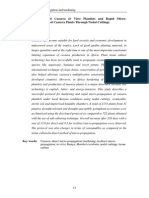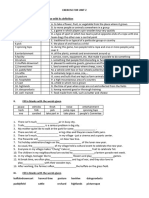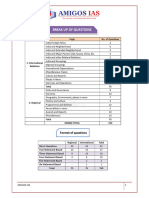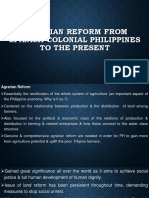Professional Documents
Culture Documents
Multiplication of Honeybee (Apis Mellifera Adansonii L.) Colonies Using Three Different Low-Cost Model Nucleus Hives Design in Two Main Vegetation Zones of Nigeria
Multiplication of Honeybee (Apis Mellifera Adansonii L.) Colonies Using Three Different Low-Cost Model Nucleus Hives Design in Two Main Vegetation Zones of Nigeria
Original Title
Copyright
Available Formats
Share this document
Did you find this document useful?
Is this content inappropriate?
Report this DocumentCopyright:
Available Formats
Multiplication of Honeybee (Apis Mellifera Adansonii L.) Colonies Using Three Different Low-Cost Model Nucleus Hives Design in Two Main Vegetation Zones of Nigeria
Multiplication of Honeybee (Apis Mellifera Adansonii L.) Colonies Using Three Different Low-Cost Model Nucleus Hives Design in Two Main Vegetation Zones of Nigeria
Copyright:
Available Formats
Volume 8, Issue 8, August – 2023 International Journal of Innovative Science and Research Technology
ISSN No:-2456-2165
Multiplication of Honeybee (Apis mellifera
Adansonii L.) Colonies using Three Different
Low-Cost Model Nucleus Hives Design in Two
Main Vegetation Zones of Nigeria
Ayoade Alabi Akande1; Akeem Abolade Oyerinde2; Toba Samuel Anjorin 3; Liadi Muideen Tella4; Ismail Adeniran Aderolu5
Department of Crop Protection, Faculty of Agriculture, University of Abuja, Nigeria
Federal University of Agriculture Abeokuta
Abstract:- There is a growing need for additional pollinators (Akunne, 2015). In Nigeria, due to increase in
honeybee colonies to satisfy the demand for pollination government focus on agriculture, which includes
services and compensate for high colony mortality beekeeping, to tackle unemployment and increase food
through bush burning, vandalization and pesticide security, there has been a surge in the number of beekeepers,
poisoning. This study evaluates the preference of and this keeps growing (Oyerinde and Ande, 2009).
different nucleus hive to the establishment of colony and
how to mitigate the associated pests and diseases in the Multiplying colonies is achieved by creating a new
practice. This was carried out in the forest (7.50oN, 4.52 colony with a young, mated queen, drone and worker
o
E) and savanna (8.98 o N, 7.19 o E) agroecological zones (Ambrose, 2008). Despite the efforts of beekeepers, the
of Nigeria. The experiment at the two locations was available bee colonies in Nigeria still do not meet the
layout using Randomized Complete Design (RCBD), demand for honey production at the local level (Ojeleye,
data collected were analyzed using SPSS Version 22. The 2009; Bekele et al., 2017).
data collected in both AEZ include the rate of colony
establishment which clearly shows that wooden hive Like other living organisms, the life and products of
have 63% followed by bamboo with 62% and the least honeybees are affected by harmful diseases, pests and toxic
was carton with 37% savannah AEZ in the same vein the materials. Successful beekeeping requires regular and on
colony establishment at rain forest AEZ shows that time monitoring of any factor that endangers honeybee life
wooden hive gave 53% followed by bamboo with 49% and threaten their products (Desalegn and Begna, 2015).
and carton with 32%. Number of incoming bees that Honeybee pests have been identified as one of the major
clearly show the strength of the colony was higher in biotic factors affecting the successful beekeeping practice in
wooden hive with 36.31/min, bamboo 33.40/min and Nigeria (Oyerinde and Ande, 2009).
27.29/min in carton, followed by wooden and the least
was in carton colony weight, brood length, incidence of Honeybee colonies existing in the wild produce small
pest and infestation of diseases as well as colony quantity of honey above their requirements, but modern
abscondment rate at week intervals. A total number of beekeeping is much more productive and profitable if
24 nucleus hives made from different low-cost model of managed properly (Chala et al., 2012). To this reality,
materials were deployed in the two agroecological zones. protecting them from disease and pests have been
The result shows that the bamboo and the wooden hives recognized many centuries back and the goal of beekeepers
gave similar result while carton were significantly is to make the beekeeping more profitable by protecting
different from the two hives model earlier mentioned. colonies from pest, pathogen, and bee diseases. (Desalegn
The findings from this study portrayed that bee farmers and Begna, 2015).
in Nigeria can adopt the use of low-cost materials of
bamboo and carton to raise nucleus hives for To meet the increasing demand for honeybee colonies
establishment of colony in modern beekeeping practice. for new beekeepers and to combat the increasing rate of
colony abscondment, there is the urgent need to develop
Keywords:- Colony Establishment, Bamboo Carton and strategies and tools to enhance colony multiplication. This
Wooden nuc Hives, Pests, Diseases. study examines the use of waste materials to produce
nucleus hives for colony establishment in the forest and
I. INTRODUCTION savana agroecological zones of Nigeria.
Apis mellifera L., is an insect of crucial economic, Not many new beekeepers can afford to buy
agricultural, and environmental importance. Apis mellifera established nucleus colony at price of N 15,000- N 25,000
adansonii is about the most common species that has been per one. But if we can make one that is acceptable by bees at
given due attention in Nigeria probably because of its affordable price it will help to move the sector forward.
beneficial attributes as the most important of all insect Also, the wandering wild colonies or swarm looking for new
IJISRT23AUG411 www.ijisrt.com 355
Volume 8, Issue 8, August – 2023 International Journal of Innovative Science and Research Technology
ISSN No:-2456-2165
abode can easily find one around them and colonise it before production and pollination. This research work attempts to
the farmer will transfer it into the production hive. The need compare the productivity and bee preference to different
to increase the number of bee colonies as a wide number of nucleus hive types and the efficiency of various baits with a
beekeepers are coming into the sector and the major view of improving bee farmer’s productivity and economic
challenge for this new beekeeper is how to attract bees into benefits.
their hives for the cost of buying one is expensive and not
sustainable for honey production and for crop pollination. In II. MATERIALS AND METHODS
addition, the influence of climate change, use of pesticides
and the rate at which the bees are dying in different climes Experimental Field
calls for research on how we can increase the colonies This study was conducted at the Teaching and
naturally in a sustainable way without tampering with the Research Farms of Faculty of Agriculture, University of
genetic makeups of our bees. Abuja (8 °58'N, 7 °10'E) and the Obafemi Awolowo
University (7° 31'N, 4° 31'E). The two sites were carefully
The aim of this study is to multiply bee colonies using selected before siting the apiary research there. The features
different models of nucleus hives (Apis mellifera A.) and to of the two sites in terms of forage were the presence of
scale up honeybee colony multiplication technology in banana plants, citrus plants, mango trees and some wild
Nigeria in other to build beekeepers capacity in applying growing trees. There were small streams that pass through
sustainable beekeeping methods for maximum honey the two project sites which does not dry all the year round.
Fig 1 Map of Nigeria Showing the States Visited in Forest and Guinea Savannah Zones.
Experimental Design Statistical Analysis:
The study was set up in a Randomized Complete Block Data obtained was tested to assess the differences in
Design RCBD with four replicates. Three types of nucleus colony strength, acceptability of the nucleus hive designs,
hives namely: wooden, bamboo and carton hives were and the durability of the materials used for the making of the
assessed for colony establishment, pest and disease nucleus hives and in-between variables using SPSS
incidence in two agroecological zones (rainforest and Software Version 21. Means were separated using Duncan
derived savannah) of Nigeria. The nucleus hives were Multiple Range Test (p<0.05).
randomly sited at four different locations per site. Data were
collected on weekly and fortnightly, depending on the
measurement taken.
IJISRT23AUG411 www.ijisrt.com 356
Volume 8, Issue 8, August – 2023 International Journal of Innovative Science and Research Technology
ISSN No:-2456-2165
III. RESULTS AND DISCUSSION wooden and bamboo hives. Wooden hive had 36.31/min
while bamboo recorded 33.40/min, the values recorded for
Weekly Variations in Colony Performance in Three wooden and bamboo hives were both significantly different
Different Nucleus Hives in Abuja from carton 27.39/min. Brood length of hives significantly
Table1 shows weekly variations in colony performance differed between carton, wooden and bamboo hives.
in three different nucleus hives in Abuja. There was Wooden hives had 27.58cm, bamboo had 28.46cm while
significant difference in colonization rate of bees in three carton recorded 16.5cm. There was no significant difference
different nucleus at p<0.05. Wooden had 0.86% in comb count between the wooden and bamboo hive: which
colonization rate; Bamboo had 0.70% while carton had recorded 6.29 and 6.17 respectively(p>0.05) while Carton
0.38%. In terms of colony weight, wooden hive had 9.5kg, hive recorded 3.70 which significantly lower compared to
bamboo had 7.29kg while carton hive had 3.56kg. There the wooden and bamboo hive.
was significant difference in the rate of bee colony flight for
Table 1 Mean Variations in Colony Performance in Three Different Nucleus Hives in Abuja
Bee character Wooden Hive Bamboo Hive Carton Hive
Colonization rate (%) 0.63b 0.62b 0.37a
a b
Colony weight (kg) 9.56 7.29 3.56c
b b
Number of incoming bee/min 36.31 33.40 27.29a
b b
Brood length (cm) 27.58 28.46 16.50a
b b
Comb count 6.29 6.17 3.70a
Means in the same row with different alphabets are significantly different (P<0.05)
Weekly Variations in Colony Performance in Three significantly difference in bee entry flight in different hives.
Different Nucleus Hives in Ile – Ife Wooden hive had 43.17/min, bamboo had 37.63/min while
Table 2 shows the colony performance of three carton hive recorded 37.61/min. Brood length recorded for
different hives in Ile-Ife. There was a significant difference the different hives had no significant difference at P<0.05.
in bee colonization rate in different hives at P<0.05. Wooden hive recorded 13.41 cm; bamboo hive recorded
Wooden hive had colonization ratio of 0.53% bamboo 16.29 cm while carton hive had 9.67 cm. There was no
recorded 0.49% while carton hive had 0.32%. The colony significant in comb count in the different hives. Wooden
weight of different hives also varied. Bamboo and carton hive had 3.40; bamboo had 3.73, while carton hive had 2.81.
hives recorded 4.78 kg and 4.12 kg respectively and are both
Table 2 Mean Variations in Colony Performance in Three Different Nucleus Hives in Ile-Ife
Bee character Wooden Hive Bamboo Hive Carton Hive
Colonization rate 0.53b 0.49b 0.32a
Colony weight 6.03b 4.78a 4.12a
Bee entering flight 43.17a 37.63a 37.61a
Brood length 13.41ab 16.29b 9.67a
Comb count 3.40a 3.73a 2.81a
Means in the same row with different alphabets are significantly different (P<0.05)
Figure 2 shows the seasonal variation across the first 8 Though the colony weight of the bamboo hives is higher
weeks (dearth season), second 8 weeks (swarming season) than that of carton. It slopes down towards the swarming
and the third 8 weeks (nectar flow season). The graph shows season and later picked up steadily as we approach the
that colony weight of the honeybees is highest in wooden nectar flow season. Carton hives almost maintained its
hives at the dearth, swarming and nectar flow season. The weight from swarming season to nectar flow season.
carton gave the least colony weight at the three seasons.
IJISRT23AUG411 www.ijisrt.com 357
Volume 8, Issue 8, August – 2023 International Journal of Innovative Science and Research Technology
ISSN No:-2456-2165
Effect of Seasonal Variation on Colony Weight of Honeybees in Three Types of Hives in Abuja.
Fig 2 Effect of Seasonal Variation on Colony Weight of Honeybees in Three Types of Hives in Abuja
Figure 3 shows the seasonal variations across the first 8 weeks (dearth season), second 8 weeks (swarming season) and the
third 8 weeks (nectar season). The graph shows that the colony weight of the wooden hives at Ile-ife was the highest at all the
seasons following by bamboo and the carton was the least during the dearth season. But the colony weight was consistently
increasing towards the swarming season and the nectar flow season. Carton hives shows that there is steady increment along all
the seasons.
There is a sharp increase in the colony weight of that of bamboo from swarming season to that of nectar flow season
compared to the wooden and the carton.
Effect of Seasonal Variation on Colony Weight of Honeybees in Three Types of Hives in Ile-Ife, Nigeria.
Fig 3 Effect of Seasonal Variation on Colony Weight of Honeybees in Three Types of Hives in Ile-Ife, Nigeria
IJISRT23AUG411 www.ijisrt.com 358
Volume 8, Issue 8, August – 2023 International Journal of Innovative Science and Research Technology
ISSN No:-2456-2165
IV. DISCUSSION The natural splitting does occur before splitting the colonies
into two. It shows that four top bar combs with equal
Three hive types designed using different materials distribution of the arrangement in the hives gives a better
such as wood, bamboo and carton were used in the study stability and adaptation to the splitted colony.
and were all shown to have variations in the preference of
honeybee colonization. REFERENCES
Comparison of the rate of colonization of honeybees in [1]. Abou Shaara HF (2014) The foraging behaviour of
the two different agroecological zones showed a faster rate honeybees, Apis mellifera: a review. Veterinarni
of colonization in wooden hives located in guinea savannah Medicina 59(1): 1-10.
at 2week after installation compared to the rain forest zone [2]. Adjare, S.O. (1990). Beekeeping in Africa. FAO
which colonized at 6weeks after installation. This Agricultural Series, Bulletin 68/6 Rome, Italy p.100-
observation agrees with the findings of Wasiam et al., 150.
(2018) (Using within-day hive weight changes to measure [3]. Ahmed, A.M. (1991). Beeswax Ointment. J.
environmental effects on honeybee colonies). The difference Beekeeping and Development 19:14-15.
in the rate of colonization in the two ecological zones could [4]. Aidoo, K.S. and Paxton, R.J. (1991). Low-cost
be because of honeybee preference for the hive material, foundation. J. Beekeeping and Development 21: 14-
rainfall duration, pollen availability and density. 15.
[5]. Aleksandar Uzunov, Cecilia Costa, Beata Panasiuk,
The honeybee preference for hive colonization is more Marina Meixner, Per Kryger, Fani Hatjina, Maria
related to some factors which are dearth, swarming and Bouga, Sreten Andonov, Malgorzata Bienkowska,
nectar seasons, the weather condition, the height of the hives Yves Le Conte, Jerzy Wilde, Dariusz Gerula, Hrisula
from the ground, the prevalence of the insect pest or ants Kiprijanovska, Janja Filipi, Plamen Petrov, Lauri
and the type of the materials used in construction of the hive Ruottinen, Hermann Pechhacker, Stefan Berg,
Akinbi, O.J, 2021. Colonization of the honeybees was a Winfried Dyrba, Evgeniya Ivanova & Ralph Büchler)
little bit delayed during the June to July which led to few Swarming, defensive and hygienic behaviour in
hives’ colonization, this was the dearth season when nectar honeybee colonies of different genetic origin in a
and pollens were scarce. This could be largely affected by pan-European experiment. Journal of apicultural
the intense rain at 230mm/annum, cold weather condition, research 53(2): 248-260.
inadequate pollen, and nectars around this period of the year [6]. Ali, M.A.M (2011). Comparative study for
at Abuja agro-ecological zone. The same type of observation evaluating two honeybee races, Apis mellifera
was established by Alexander et al., 2017). At initial period, jementica (indigenous race) and Apis mellifera
only wooden hive was able to attract swarm while the carnica (Carniolan race) in brood production,
bamboo and the carton have no colony in them. From population development and foraging activity under
August to September when pollen and nectar begin to come, the environmental conditions of the central region of
bees’ population begins to increase and the colonization the Kingdom of Saudi Arabia. Annals of Agricultural
were also affected positively as the bamboo and the carton Sciences 56(2): 127-134.
were colonized in ratio 2;1. The carton was not too strong to [7]. Amorim, J.A. and Ribeiro, O.B. (2001). Distinction
withstand the weather condition within this period leading to among the puparia of three blowfly species (Diptera:
some of the carton being damaged due to high humidity and Calliphoridae) frequently found on unburied corps.
wind (Kugonza et al., 2008), hive types (Ande et al., 2008), Mem. Inst. Oswaldo Cruz 96: 781 – 784.
shade tree species types (Babarinde et al., 2011) and hive [8]. Andere, C., Garcia, C., Marinelli, C., Cepeda, R.,
wood colours. Rodriguez, E.M. and Palacio, A. (2008).
Morphometric variables of honeybee used in
V. CONCLUSION ecotypes characteristics in Argentina. Ecological
Modeling 214 (1): 53-58.
This study provides information on honeybee [9]. Arias, M.C. and Sheppard, W.S. (2005).
preference for three nucleus hives in colony multiplication Phylogenetic relationships of honeybee
in two agroecological zones of Nigeria. It is of note that (Hymenoptera: Apiane: Apini) inferred from nuclear
there was a serious problem in colony establishment after and mitochondrial DNA sequence data. Molecular
setting up an apiary with so many farmers in the industry. phylogenetics and Evolution 37(1): 25-35. Doi:10.
The finding recorded show that the colony multiplication 1016/j.ympev. 2005.02.017. Erratum in Molecular
using nucleus hive of this size quoted in this research was of Phylogenetics and Evolution 40(1): 315
great help as one nucleus hive can be splitted into two doi:10.101/j.ympev.2006.02.002.
mother hive within 10 weeks of establishment provided [10]. Aytekin, A.M., Terzo, M., Rasmont, P. and Çagatay,
there are forage (nectar and pollen) around the apiary. It was N. (2007). Landmark based geometric morphometric
established that the colonisation in both agroecological analysis of wing shape in Sibiricobombus Vogt
zones were positively increased as the weeks goes by. This (Hymenoptera: Apidae: Bombus Latreille). Ann. Soc.
implies that as from September and October the colonization Entomol. Fr. 43: 95-102.
keeps increasing and all the nucleus hives that were not
colonized began to attract bees swarm and were colonised.
IJISRT23AUG411 www.ijisrt.com 359
Volume 8, Issue 8, August – 2023 International Journal of Innovative Science and Research Technology
ISSN No:-2456-2165
[11]. Babarinde SA, Olaleke SA, Akinyemi AO, Adebayo [29]. Fatunmise, F. (1997). Ifa and Beekeeping web
TA, Olaifa JI (2015) Evaluation of four apicultural copyright retrieved from
products for hive colonization by honeybees (Apis http://www.drgrotte.com/offerings to the Earth. shtml
mellifera adansonii) (Hymenoptera: Apidae) and on 5/1/07.
precolonization pests. African journal of food, [30]. Fewell JH, Winston ML (1992) Colony state and
agriculture, nutrition and development 15(2): 9826- regulation of pollen foraging in the honeybee, Apis
9837 mellifera L. Behavioral Ecology and Sociobiology
[12]. Barrette, T. (1995). Species interfertility and 30: 387-393.
crossing experiments in Triatominutee systematics. [31]. Francoy T.M., Prado P.P.R., Gonçalves L.S., Costa
In: Proceedings of the International Workshop on L.D., De Jong D. (2006). Morphometric differences
Population Genetics and Control of Triatominuteae . in a single wing cell can discriminate Apis mellifera
p. 72-77. racial types, Apidologie 37: 91–97.
[13]. Bergman, A. Yanai J., Weiss, I., Bell, D. and [32]. Francoy, T.M., Wittmann, D., Drauschke, M. and
Menachem, P.D. (1983). Acceleration of wound Müller, S. (2008). Identification of Africanized
healing by topical application of honey. An animal honeybees through wing morphometrics: two fast
models. The American J. of surgery 145:374-375. and efficient procedures. Apidologie 39: 488-494.
[14]. Boch, R. (1957). Rassenmassige Unterschiede in den [33]. Frisch, K.V. (1951). Orientierungsvermogen und
Tanzen der Honigbiene (Apis mellifera L.) Z. Vgl. Sprache der Bienen. Naturwissenschaften 38: 105 –
Physiol.39: 289-320. 112.
[15]. Bookstein, F.L. (1991). Morphometric tools for [34]. Green, A. E. (1988). Wound healing properties of
landmark data. Geometry and Biology. Cambridge honey. British J. of Surgery, 75 (12): 1278.
University Press. 435 pp. [35]. Greenberg, B. and Szyska, M. (1984). Immature
[16]. Burlando, F. (1978). About the therapeutic action of stages and biology of fifteen species of Peruvian
honey on burn wounds. Minuteerva dermatology Calliphoridae (Diptera) Ann. Entomol. Soc. Am.
113: 699-706. 77:488-517.
[17]. Canon, D.M. (1979). Queen cup and queen cell [36]. Hepburn, H.R., Radloff, S.E., Otis, G.W., Fuchs, S.,
production in honeybee colonies. Journal Verma, L.R., Ken, T., Chaiyawong, T., Tahmasebi,
Apicultural Research. 18: 253-256. G., Ebadi, R., and Wongsiri, S. (2005). Apis florea
[18]. Caufeld, K. (1985). In the rainforest: Knopf, New morphometrics, classification and biogeography.
York 218pp. Apidologie 36:359-376.
[19]. Chinaka, (1995). Beekeeping Technologies for [37]. Howpage, D. (1991). The Apiculture Development
Nigerian Farmers. National Agricultural Extension Project of Srilanka. Journal of Beekeeping and
and Research Liaison Services (NAERLS) Ahmadu Development 19:10-11.
Bello University, Zaria Nigeria Extension Bulletin
No.3. 33pp
[20]. Crane, E. (1990). Bees and beekeeping: Science
practice and World Resources. Comstock Publishers.
Ithaca, NY., USA. 595pp.
[21]. Dallin, J. (2008). How to convert from pixels to
millimeters. Retrieved from
http://www.dallinJones.com/ on 4/12/2008.
[22]. DBAR, (2008). Beekeeping in Africa. In: Danish
Beekeeper Association Report. Retrieved from
http://www.biavl.c/k/ on 4/12/2008.
[23]. Denis, L.J. (1966). Chronic Protatistics. Acta Urol.
Belgium. 34: 49-56.
[24]. Denisova, L.M. and Polishchuk, L.A. (1970).
Carbon Paper. USSR Pat. No. 275732.
[25]. Dryden, I.L. and Mardia, K.V. (1998). Statistical
shape analysis. John Wiley & Sons, London, 425 pp.
[26]. Eckert, J.E and Shaw, F.R. (1960). Beekeeping:
Successor to Beekeeping. The Macmillan New York.
597pp.
[27]. El-Sabbagh, H.M., Abdel-Gawad, H.A and El-Said,
Y. (1988). Development and Characterization of an
Oleagineous suppository base. Alexandria Journal of
Pharmaceutical Science 2 (1): 80-84.
[28]. Engel, M.S. (1999). The taxonomy of recent and
fossil honeybee (Hymenoptera: Apidae: Apis).
Journal of Hymenoptera Research 8: 165-196.
IJISRT23AUG411 www.ijisrt.com 360
You might also like
- K. T. Achaya - A Historical Dictionary of Indian Food-Oxford University Press (1998)Document364 pagesK. T. Achaya - A Historical Dictionary of Indian Food-Oxford University Press (1998)Mahender RawatNo ratings yet
- Research ProposalDocument6 pagesResearch Proposalanon-48724100% (3)
- Comparative Study On The Phenology and Yield Components of Two Photoperiodic Groups of Cowpea ManggoelDocument10 pagesComparative Study On The Phenology and Yield Components of Two Photoperiodic Groups of Cowpea ManggoelMadjokfaOscarNo ratings yet
- Are Epiphytes Important For Birds in Coffee Planta PDFDocument11 pagesAre Epiphytes Important For Birds in Coffee Planta PDFvalentinaNo ratings yet
- neemprojectEXPODocument7 pagesneemprojectEXPOSAI RAM PRATAPNo ratings yet
- BeekeepingDocument7 pagesBeekeepingrkvaitlaNo ratings yet
- Isolation and Identification of Cassava Mill Effluents Utilizing Microorganisms From Five Cassava Processing Plants in Anambra StateDocument6 pagesIsolation and Identification of Cassava Mill Effluents Utilizing Microorganisms From Five Cassava Processing Plants in Anambra StateEditor IJTSRDNo ratings yet
- An Approach Towards Induction of Double Haploids in Okra (Abelmoschus Esculentus L. Moench)Document4 pagesAn Approach Towards Induction of Double Haploids in Okra (Abelmoschus Esculentus L. Moench)Shailendra RajanNo ratings yet
- tmpF4AB TMPDocument5 pagestmpF4AB TMPFrontiersNo ratings yet
- Bamboo Tissue CultureDocument12 pagesBamboo Tissue Culturemobyelectra100% (1)
- Breeding Success of New Zealand Falcons (Falco Novaeseelandiae) in A Pine PlantationDocument8 pagesBreeding Success of New Zealand Falcons (Falco Novaeseelandiae) in A Pine PlantationZeeshan Khalid ChaudheryNo ratings yet
- Evolution and health status of Cassava (Manihot esculenta Crantz) genetic resources in ex-situ conservation in Côte d’IvoireDocument8 pagesEvolution and health status of Cassava (Manihot esculenta Crantz) genetic resources in ex-situ conservation in Côte d’IvoireOpenaccess Research paperNo ratings yet
- Effect of Moisture Content On Some Engineering Properties of African Mahogany (Afzelia Africana) SeedDocument20 pagesEffect of Moisture Content On Some Engineering Properties of African Mahogany (Afzelia Africana) SeedAZOJETE UNIMAIDNo ratings yet
- Bio Diversity of Insects and Their Distribution Pattern in Miyawaki Plantation of Coimbatore, Tamil NaduDocument6 pagesBio Diversity of Insects and Their Distribution Pattern in Miyawaki Plantation of Coimbatore, Tamil NaduAnand SundaramNo ratings yet
- Research Article Management of Root-Knot Nematode, Meloidogyne Javanica On African Yam Bean With Pig ExcrementsDocument6 pagesResearch Article Management of Root-Knot Nematode, Meloidogyne Javanica On African Yam Bean With Pig ExcrementsAjuziogu, Godswill ChukwunonsoNo ratings yet
- Callosobruchus Maculatus (F.) On Different LegumeDocument5 pagesCallosobruchus Maculatus (F.) On Different LegumeIJEAB JournalNo ratings yet
- Plant Breeding - 2018 - Boukar - Cowpea Vigna Unguiculata Genetics Genomics and BreedingDocument10 pagesPlant Breeding - 2018 - Boukar - Cowpea Vigna Unguiculata Genetics Genomics and BreedingGisele HolandaNo ratings yet
- Melipona MonduryDocument7 pagesMelipona MonduryHamashihaNo ratings yet
- Survey of Endangered Woody Plants Species in Dandi Local Government Area, Kebbi State, North-Western, NigeriaDocument5 pagesSurvey of Endangered Woody Plants Species in Dandi Local Government Area, Kebbi State, North-Western, NigeriaInternational Journal of Innovative Science and Research TechnologyNo ratings yet
- Germplasm Conservation As A Key For Food Security-IJRASETDocument5 pagesGermplasm Conservation As A Key For Food Security-IJRASETIJRASETPublicationsNo ratings yet
- Optimization of Alocasia Amazonica ProliferationDocument8 pagesOptimization of Alocasia Amazonica ProliferationRobertFWainblatIIINo ratings yet
- Tsanakas2018 LensDocument9 pagesTsanakas2018 Lenskhalil khamassiNo ratings yet
- Yuan 2011Document6 pagesYuan 2011khalil khamassiNo ratings yet
- Distribution and Effects of Nematode Management On Plant Parasitic Nematodes in Selected Old and Moribund Cocoa Farms in South Western NigeriaDocument10 pagesDistribution and Effects of Nematode Management On Plant Parasitic Nematodes in Selected Old and Moribund Cocoa Farms in South Western NigeriaPremier PublishersNo ratings yet
- Journal Homepage: - : IntroductionDocument10 pagesJournal Homepage: - : IntroductionIJAR JOURNALNo ratings yet
- Low Cost Tissue Culture Technology in The Regeneration of Sweet Potato (Ipomoea Batatas (L) Lam)Document9 pagesLow Cost Tissue Culture Technology in The Regeneration of Sweet Potato (Ipomoea Batatas (L) Lam)Jaru JackyNo ratings yet
- Saudi Journal of Biological SciencesDocument7 pagesSaudi Journal of Biological SciencesTiara KemetaNo ratings yet
- Rearing Method and Life-Table For The Cocoa Mirid Bug Sahlbergella Singularis Haglund (Hemiptera: Miridae)Document10 pagesRearing Method and Life-Table For The Cocoa Mirid Bug Sahlbergella Singularis Haglund (Hemiptera: Miridae)José CedeñoNo ratings yet
- Advances in Crop Science and TechnologyDocument4 pagesAdvances in Crop Science and TechnologyLydya SetyaNo ratings yet
- Chapter 1,2,3Document19 pagesChapter 1,2,3Fritz Melvin DulguimeNo ratings yet
- 483-Article Text-2635-1-10-20201119Document8 pages483-Article Text-2635-1-10-20201119UMT JournalsNo ratings yet
- Sjavs 108 99-113Document15 pagesSjavs 108 99-113Creyente Del Agua ClaraNo ratings yet
- Diversity of Sunflower Pollinators and Their EffecDocument9 pagesDiversity of Sunflower Pollinators and Their EffecSudipta SarkarNo ratings yet
- Effectiveness of acoustic lures for increasing tropical forest understory bat. Aylen et al 2022Document9 pagesEffectiveness of acoustic lures for increasing tropical forest understory bat. Aylen et al 2022Fernando BalseiroNo ratings yet
- Phenotypical Characterization of Cassava (Manihot Esculenta Crantz) Accessions in Cameroon's Mono-Modal Rainforest ZoneDocument11 pagesPhenotypical Characterization of Cassava (Manihot Esculenta Crantz) Accessions in Cameroon's Mono-Modal Rainforest ZoneIJEAB JournalNo ratings yet
- Article1397576486 - Balogun Et AlDocument9 pagesArticle1397576486 - Balogun Et AlFarah HabibahNo ratings yet
- A Commercial Micropropagation Protocol For VirupakshiDocument7 pagesA Commercial Micropropagation Protocol For Virupakshizmus zmustaphaNo ratings yet
- Animal Communication - CURRENT SCIENCE, VOL. 85, NO. 10, 25 NOVEMBER 2003Document3 pagesAnimal Communication - CURRENT SCIENCE, VOL. 85, NO. 10, 25 NOVEMBER 2003gabriela ruizNo ratings yet
- Investigation of Cowpea Variety and Storage Methods On Cowpea Beettle InfestationDocument6 pagesInvestigation of Cowpea Variety and Storage Methods On Cowpea Beettle InfestationIJEAB JournalNo ratings yet
- Merging Biotechnology With Biological Control: Banana Musa Tissue Culture Plants Enhanced by Endophytic FungiDocument7 pagesMerging Biotechnology With Biological Control: Banana Musa Tissue Culture Plants Enhanced by Endophytic FungiAkash DoiphodeNo ratings yet
- Egg Mass Analysis of The Pine Processionary Moth, ThaumetopoeaDocument10 pagesEgg Mass Analysis of The Pine Processionary Moth, ThaumetopoeaTJPRC PublicationsNo ratings yet
- ALKPOWv 1Document8 pagesALKPOWv 1Charisma FauziNo ratings yet
- Protocol Optimisation For Micropropagation of Ethiopian YAMDocument15 pagesProtocol Optimisation For Micropropagation of Ethiopian YAMbahiran alwaysNo ratings yet
- Influence of Cow Manure and Variety on Growth and Yield of Sesame ( L.) in Influence of Cow Manure and Variety on Growth and Yield of Sesame (Sesanumindicum L.) in Lafia, Nasarawa StateDocument9 pagesInfluence of Cow Manure and Variety on Growth and Yield of Sesame ( L.) in Influence of Cow Manure and Variety on Growth and Yield of Sesame (Sesanumindicum L.) in Lafia, Nasarawa Stateisajibrin078No ratings yet
- Bioscientific Review (BSR)Document9 pagesBioscientific Review (BSR)UMT JournalsNo ratings yet
- Development of The Mass-Rearing Technique For A Predatory Mite Stratiolaelaps Scimitus (Acari - Laelapidae) Using The Double Box SystemDocument8 pagesDevelopment of The Mass-Rearing Technique For A Predatory Mite Stratiolaelaps Scimitus (Acari - Laelapidae) Using The Double Box SystemErnesto FloresNo ratings yet
- Ajol File Journals - 90 - Articles - 119952 - Submission - Proof - 119952 1069 330668 1 10 20150724Document6 pagesAjol File Journals - 90 - Articles - 119952 - Submission - Proof - 119952 1069 330668 1 10 20150724acirnusosNo ratings yet
- Unguiculata L.) Due To Root-Knot Nematode, Meloidogyne Incognita Under Field ConditionsDocument7 pagesUnguiculata L.) Due To Root-Knot Nematode, Meloidogyne Incognita Under Field ConditionsmucksoodganaieNo ratings yet
- Induced Mutagenesis of Flowering, Phenology and Yield in M1 Generation of Bambara Groundnut Vigna Subterrnea L. VerdcDocument9 pagesInduced Mutagenesis of Flowering, Phenology and Yield in M1 Generation of Bambara Groundnut Vigna Subterrnea L. VerdcEditor IJTSRDNo ratings yet
- Cassava HardeningDocument7 pagesCassava HardeningBrij Mohan SinghNo ratings yet
- Efficiency of trap nests in attracting stingless bees in the central Brazilian AmazonDocument9 pagesEfficiency of trap nests in attracting stingless bees in the central Brazilian AmazonValmira CruzNo ratings yet
- PCR Mori ReviewDocument15 pagesPCR Mori ReviewRay MrinalNo ratings yet
- Rwetsibaetal 2021Document22 pagesRwetsibaetal 2021mbusa josephNo ratings yet
- A Report of Meloidogyne Arenaria Parasitizing Plantain (Musa SPP., AAB) in NigeriaDocument4 pagesA Report of Meloidogyne Arenaria Parasitizing Plantain (Musa SPP., AAB) in NigeriaOlajide Emmanuel OlorunfemiNo ratings yet
- Fgene 11 00546Document14 pagesFgene 11 00546Karla MontesNo ratings yet
- Ecological Informatics: Selcan Kaplan Berkaya, Efnan Sora Gunal, Serkan GunalDocument11 pagesEcological Informatics: Selcan Kaplan Berkaya, Efnan Sora Gunal, Serkan GunalJuan Luis Saldaña MéndezNo ratings yet
- Optimization of Explants Density For Tissue Culture: Propagation of Banana Cv. 'Document6 pagesOptimization of Explants Density For Tissue Culture: Propagation of Banana Cv. 'Aaser Ammar Ali HassanNo ratings yet
- Euschistus Heros Soybean BlockDocument9 pagesEuschistus Heros Soybean Blockjoicy moraesNo ratings yet
- Infrared Physics & Technology: Regular ArticleDocument7 pagesInfrared Physics & Technology: Regular ArticleJoelma SilvaNo ratings yet
- 483-487 (3591)Document5 pages483-487 (3591)Thein NaingNo ratings yet
- Solar Based Multilevel Inverter f o r BLDC Motor DriveDocument8 pagesSolar Based Multilevel Inverter f o r BLDC Motor DriveInternational Journal of Innovative Science and Research TechnologyNo ratings yet
- Unlocking Sentiments: Enhancing IOCL Petrol Pump ExperiencesDocument8 pagesUnlocking Sentiments: Enhancing IOCL Petrol Pump ExperiencesInternational Journal of Innovative Science and Research TechnologyNo ratings yet
- Exploring the Potential Advantages of Traditional Therapies in Autoimmune Blistering Illnesses: A Comprehensive Review and Analysis, ResearchDocument12 pagesExploring the Potential Advantages of Traditional Therapies in Autoimmune Blistering Illnesses: A Comprehensive Review and Analysis, ResearchInternational Journal of Innovative Science and Research TechnologyNo ratings yet
- Smart and Secure Home with ChatbotDocument9 pagesSmart and Secure Home with ChatbotInternational Journal of Innovative Science and Research TechnologyNo ratings yet
- Meta Land: Redefining Virtual Communities through Centralized Governance, Inclusivity and InnovationDocument5 pagesMeta Land: Redefining Virtual Communities through Centralized Governance, Inclusivity and InnovationInternational Journal of Innovative Science and Research TechnologyNo ratings yet
- Seasonal Variation and Distribution Patterns of Endophytic Community in Withania somniferaDocument7 pagesSeasonal Variation and Distribution Patterns of Endophytic Community in Withania somniferaInternational Journal of Innovative Science and Research TechnologyNo ratings yet
- Skin Disease Detection and Remedial SystemDocument7 pagesSkin Disease Detection and Remedial SystemInternational Journal of Innovative Science and Research TechnologyNo ratings yet
- Design and Development of Multi-Featured Medical StretcherDocument4 pagesDesign and Development of Multi-Featured Medical StretcherInternational Journal of Innovative Science and Research TechnologyNo ratings yet
- Global Warming Reduction Proposal AssessmentDocument6 pagesGlobal Warming Reduction Proposal AssessmentInternational Journal of Innovative Science and Research TechnologyNo ratings yet
- Development of Smart Ground Fault Location Model for Radial Distribution SystemDocument14 pagesDevelopment of Smart Ground Fault Location Model for Radial Distribution SystemInternational Journal of Innovative Science and Research TechnologyNo ratings yet
- EmoConnect: Nurturing Trust and Relationship Bonds in Alzheimer’s ConversationsDocument3 pagesEmoConnect: Nurturing Trust and Relationship Bonds in Alzheimer’s ConversationsInternational Journal of Innovative Science and Research TechnologyNo ratings yet
- Preparation and Identification of Magnetic Iron Nanoparticle based on a Natural Hydrogel and its Performance in Targeted Drug DeliveryDocument17 pagesPreparation and Identification of Magnetic Iron Nanoparticle based on a Natural Hydrogel and its Performance in Targeted Drug DeliveryInternational Journal of Innovative Science and Research TechnologyNo ratings yet
- Firm Size as a Mediator between Inventory Management Andperformance of Nigerian CompaniesDocument8 pagesFirm Size as a Mediator between Inventory Management Andperformance of Nigerian CompaniesInternational Journal of Innovative Science and Research TechnologyNo ratings yet
- Application of Plant Growth Promoting Rhizobacteria on Vegetative Growth in Chili Plants (Capsicum frutescens L.)Document7 pagesApplication of Plant Growth Promoting Rhizobacteria on Vegetative Growth in Chili Plants (Capsicum frutescens L.)International Journal of Innovative Science and Research TechnologyNo ratings yet
- Reading Intervention Through “Brigada Sa Pagbasa”: Viewpoint of Primary Grade TeachersDocument3 pagesReading Intervention Through “Brigada Sa Pagbasa”: Viewpoint of Primary Grade TeachersInternational Journal of Innovative Science and Research TechnologyNo ratings yet
- On the Development of a Threat Driven Model for Campus NetworkDocument14 pagesOn the Development of a Threat Driven Model for Campus NetworkInternational Journal of Innovative Science and Research TechnologyNo ratings yet
- PHREEQ C Modelling Tool Application to Determine the Effect of Anions on Speciation of Selected Metals in Water Systems within Kajiado North Constituency in KenyaDocument71 pagesPHREEQ C Modelling Tool Application to Determine the Effect of Anions on Speciation of Selected Metals in Water Systems within Kajiado North Constituency in KenyaInternational Journal of Innovative Science and Research TechnologyNo ratings yet
- Exploring the Post-Annealing Influence on Stannous Oxide Thin Films via Chemical Bath Deposition Technique: Unveiling Structural, Optical, and Electrical DynamicsDocument7 pagesExploring the Post-Annealing Influence on Stannous Oxide Thin Films via Chemical Bath Deposition Technique: Unveiling Structural, Optical, and Electrical DynamicsInternational Journal of Innovative Science and Research TechnologyNo ratings yet
- Osho Dynamic Meditation; Improved Stress Reduction in Farmer Determine by using Serum Cortisol and EEG (A Qualitative Study Review)Document8 pagesOsho Dynamic Meditation; Improved Stress Reduction in Farmer Determine by using Serum Cortisol and EEG (A Qualitative Study Review)International Journal of Innovative Science and Research TechnologyNo ratings yet
- A Study to Assess the Knowledge Regarding Teratogens Among the Husbands of Antenatal Mother Visiting Obstetrics and Gynecology OPD of Sharda Hospital, Greater Noida, UpDocument5 pagesA Study to Assess the Knowledge Regarding Teratogens Among the Husbands of Antenatal Mother Visiting Obstetrics and Gynecology OPD of Sharda Hospital, Greater Noida, UpInternational Journal of Innovative Science and Research TechnologyNo ratings yet
- Application of Game Theory in Solving Urban Water Challenges in Ibadan-North Local Government Area, Oyo State, NigeriaDocument9 pagesApplication of Game Theory in Solving Urban Water Challenges in Ibadan-North Local Government Area, Oyo State, NigeriaInternational Journal of Innovative Science and Research TechnologyNo ratings yet
- Mandibular Mass Revealing Vesicular Thyroid Carcinoma A Case ReportDocument5 pagesMandibular Mass Revealing Vesicular Thyroid Carcinoma A Case ReportInternational Journal of Innovative Science and Research TechnologyNo ratings yet
- Esophageal Melanoma - A Rare NeoplasmDocument3 pagesEsophageal Melanoma - A Rare NeoplasmInternational Journal of Innovative Science and Research TechnologyNo ratings yet
- Detection of Phishing WebsitesDocument6 pagesDetection of Phishing WebsitesInternational Journal of Innovative Science and Research TechnologyNo ratings yet
- Consistent Robust Analytical Approach for Outlier Detection in Multivariate Data using Isolation Forest and Local Outlier FactorDocument5 pagesConsistent Robust Analytical Approach for Outlier Detection in Multivariate Data using Isolation Forest and Local Outlier FactorInternational Journal of Innovative Science and Research TechnologyNo ratings yet
- The Impact of Music on Orchid plants Growth in Polyhouse EnvironmentsDocument5 pagesThe Impact of Music on Orchid plants Growth in Polyhouse EnvironmentsInternational Journal of Innovative Science and Research Technology100% (1)
- Vertical Farming System Based on IoTDocument6 pagesVertical Farming System Based on IoTInternational Journal of Innovative Science and Research TechnologyNo ratings yet
- Sustainable Energy Consumption Analysis through Data Driven InsightsDocument16 pagesSustainable Energy Consumption Analysis through Data Driven InsightsInternational Journal of Innovative Science and Research TechnologyNo ratings yet
- Realigning Curriculum to Simplify the Challenges of Multi-Graded Teaching in Government Schools of KarnatakaDocument5 pagesRealigning Curriculum to Simplify the Challenges of Multi-Graded Teaching in Government Schools of KarnatakaInternational Journal of Innovative Science and Research TechnologyNo ratings yet
- Investigating Non-Newtonian Fluid Behavior in Hydrocyclones Via Computational Fluid DynamicsDocument18 pagesInvestigating Non-Newtonian Fluid Behavior in Hydrocyclones Via Computational Fluid DynamicsInternational Journal of Innovative Science and Research TechnologyNo ratings yet
- AGRI CROP 7&8 Module 8Document34 pagesAGRI CROP 7&8 Module 8Christian Nick MacniNo ratings yet
- Rodante EscavadeirasDocument70 pagesRodante EscavadeirasThiago SantosNo ratings yet
- Infrastructure and Support Services For Philippine Agriculture 2020Document2 pagesInfrastructure and Support Services For Philippine Agriculture 2020Marie Cris Gajete MadridNo ratings yet
- Exercise Unit 2Document8 pagesExercise Unit 2Hân HoàngNo ratings yet
- Peast and Diseases of CacacoDocument20 pagesPeast and Diseases of CacacoErjohn Clark Acosta TejadaNo ratings yet
- Wa0003.Document53 pagesWa0003.K vamsi KrishnaNo ratings yet
- Social Science Project WorkDocument18 pagesSocial Science Project Workshambhavi50% (2)
- CH 4 AgricultureDocument11 pagesCH 4 AgricultureMr. LuckyNo ratings yet
- Agrarian ReformDocument41 pagesAgrarian ReformRichel Marie Benaohan50% (2)
- 3 Wisions - Proyecto Detec Peru - AnexoDocument5 pages3 Wisions - Proyecto Detec Peru - AnexoCarlos MinanoNo ratings yet
- SI 98 of 2022 Customs and Excise (Suspension) (A - 220517 - 175145Document4 pagesSI 98 of 2022 Customs and Excise (Suspension) (A - 220517 - 175145Valerie MugadzawetaNo ratings yet
- CridaDocument5 pagesCridaMiqdad HussainNo ratings yet
- Objectives of CarpDocument2 pagesObjectives of CarpFlorilyn Gutierrez - Mendoza100% (2)
- Pnabh 020Document76 pagesPnabh 020MAHER FAHADNo ratings yet
- Mini-MBA in Food and Agribusiness Management SyllabusDocument12 pagesMini-MBA in Food and Agribusiness Management SyllabusJosephine ChirwaNo ratings yet
- Avocado Fruit Quality Issues On The International MarketDocument14 pagesAvocado Fruit Quality Issues On The International MarketViviana Delgado100% (1)
- 72 NBC Philippines 02 IRR of NBC of The PhilippinesDocument94 pages72 NBC Philippines 02 IRR of NBC of The PhilippinesChristine Dianne PeñaNo ratings yet
- Gmo of Rice (Golden Rice) in The PhilippinesDocument4 pagesGmo of Rice (Golden Rice) in The PhilippinesCdt.Mascarina Alaminos unitNo ratings yet
- Agricultural Sciences P2 May June 2022 EngDocument17 pagesAgricultural Sciences P2 May June 2022 EngrukieymNo ratings yet
- Alip Mike S.Document1 pageAlip Mike S.Oliver WahabNo ratings yet
- 12 Sfu 3-22-2023Document13 pages12 Sfu 3-22-2023nwberryfoundationNo ratings yet
- Proposal For Computing Research Project: A Study On Impact of Iot Based Smart AgricultureDocument17 pagesProposal For Computing Research Project: A Study On Impact of Iot Based Smart AgricultureManzu PokharelNo ratings yet
- Ch-1 Eco - Palampur Test PaperDocument7 pagesCh-1 Eco - Palampur Test PaperEDU-hunters motivating towards realmNo ratings yet
- The Nutrient Cycle: Executive SummaryDocument5 pagesThe Nutrient Cycle: Executive SummaryBenson MwathiNo ratings yet
- Agrarian ReformDocument42 pagesAgrarian ReformricoliwanagNo ratings yet
- SupaulDocument11 pagesSupaulImran ShiekhNo ratings yet
- Standard:-Vii Geography WorksheetDocument2 pagesStandard:-Vii Geography WorksheetbharatNo ratings yet
- Design and Fabrication of Grain Separator Using Solar Energy Project Reference No: 38S0809Document4 pagesDesign and Fabrication of Grain Separator Using Solar Energy Project Reference No: 38S0809roronoa zoroNo ratings yet
- Senate Resolution Supporting Farmers Bill of RightsDocument8 pagesSenate Resolution Supporting Farmers Bill of RightsSenator Cory BookerNo ratings yet





